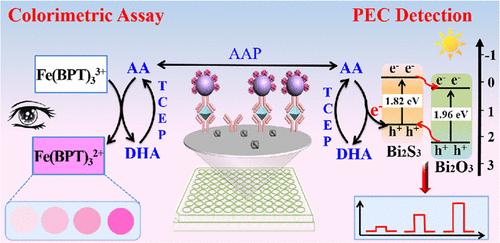一种基于化学氧化还原循环的双模生物传感器,用于热休克蛋白的自供电光电化学和比色分析
IF 9.1
1区 化学
Q1 CHEMISTRY, ANALYTICAL
引用次数: 0
摘要
为了提高对热休克蛋白(HSP)在不同类型癌症中的生物学认识,实现其准确测定至关重要。本文提出了一种结合酶催化和化学氧化还原循环放大策略的双模式自供电光电化学比色平台。在该体系中,抗坏血酸(AA)作为PEC和比色分析的信号报告蛋白,可在三(2-羧乙基)膦介导的化学氧化还原循环过程中再生。在PEC检测中,再生电子给体AA可以与Bi2S3/Bi2O3光阳极产生的空穴反复结合,有效分离光产生的电子空穴。此外,在比色试验中还引起了aa参与的显色反应,将无色的三(bathophenophine)铁(III)还原为红色的三(bathophenline)铁(II)。利用巧妙的信号放大策略,开发的双模式检测方法实现了实际样品中HSP90AA1 (HSP家族的一个亚型)的PEC和比色测定。相信本工作将提供一种制作双模生物传感器的新策略,在各种肿瘤生物标志物的检测中具有很大的应用前景。本文章由计算机程序翻译,如有差异,请以英文原文为准。

A Chemical Redox Cycling-Based Dual-Mode Biosensor for Self-Powered Photoelectrochemical and Colorimetric Assay of Heat Shock Protein
To advance the biological understanding of heat shock protein (HSP) in different types of cancers, it is crucial to achieve its accurate determination. Herein, a dual-mode self-powered photoelectrochemical (PEC) and colorimetric platform was proposed by integrating enzymatic catalysis and a chemical redox cycling amplification strategy. In this system, ascorbic acid (AA), as the signal reporter for PEC and colorimetric assay, can be regenerated during the tris(2-carboxyethyl) phosphine-mediated chemical redox cycling process. For PEC detection, the reproduced electron donor AA could repeatedly combine with holes generated by the Bi2S3/Bi2O3 photoanode to effectively separate the photogenerated electron–hole. Besides, an AA-involved color reaction was evoked during the colorimetric assay to reduce colorless tris(bathophenanthroline) iron(III) to red tris(bathophenanthroline) iron(II). Owing to the ingenious signal amplification strategy, the developed dual-mode assay achieved the PEC and colorimetric determination of HSP90AA1 (one subtype of HSP family) in real samples. It is believed that this work will offer a new strategy to fabricate a dual-mode biosensor, which has great application prospects in the detection of various tumor biomarkers.
求助全文
通过发布文献求助,成功后即可免费获取论文全文。
去求助
来源期刊

ACS Sensors
Chemical Engineering-Bioengineering
CiteScore
14.50
自引率
3.40%
发文量
372
期刊介绍:
ACS Sensors is a peer-reviewed research journal that focuses on the dissemination of new and original knowledge in the field of sensor science, particularly those that selectively sense chemical or biological species or processes. The journal covers a broad range of topics, including but not limited to biosensors, chemical sensors, gas sensors, intracellular sensors, single molecule sensors, cell chips, and microfluidic devices. It aims to publish articles that address conceptual advances in sensing technology applicable to various types of analytes or application papers that report on the use of existing sensing concepts in new ways or for new analytes.
 求助内容:
求助内容: 应助结果提醒方式:
应助结果提醒方式:


